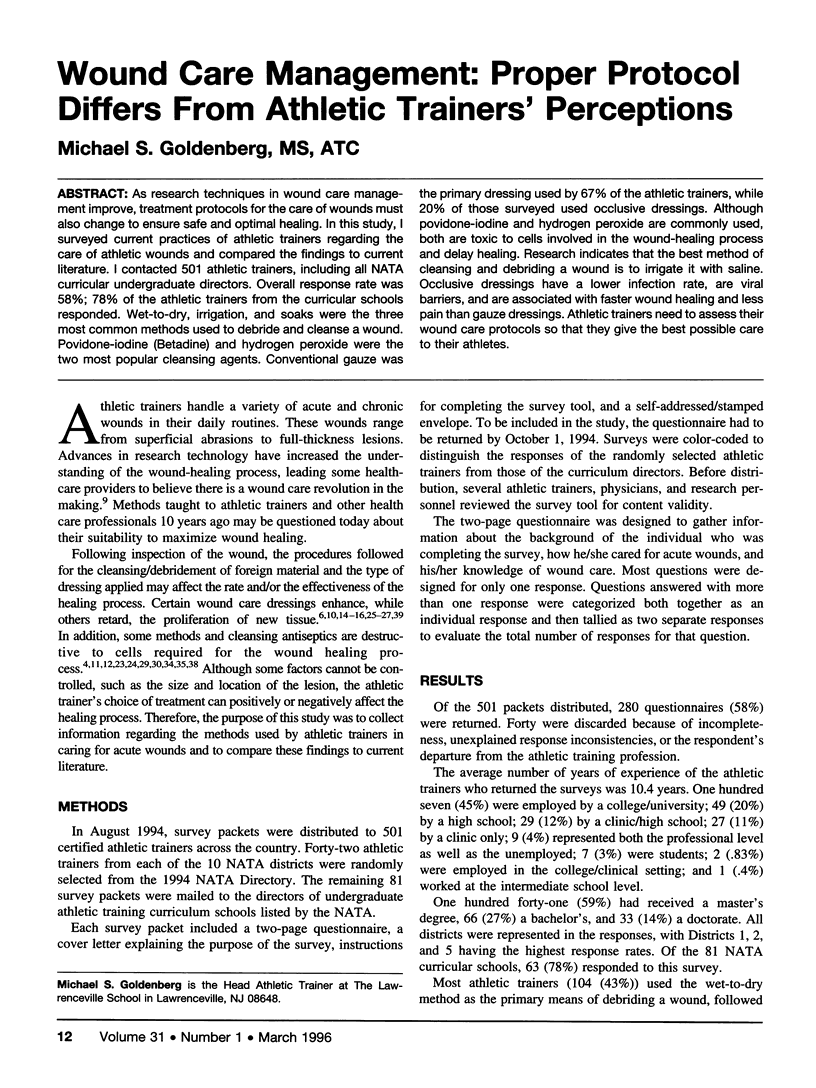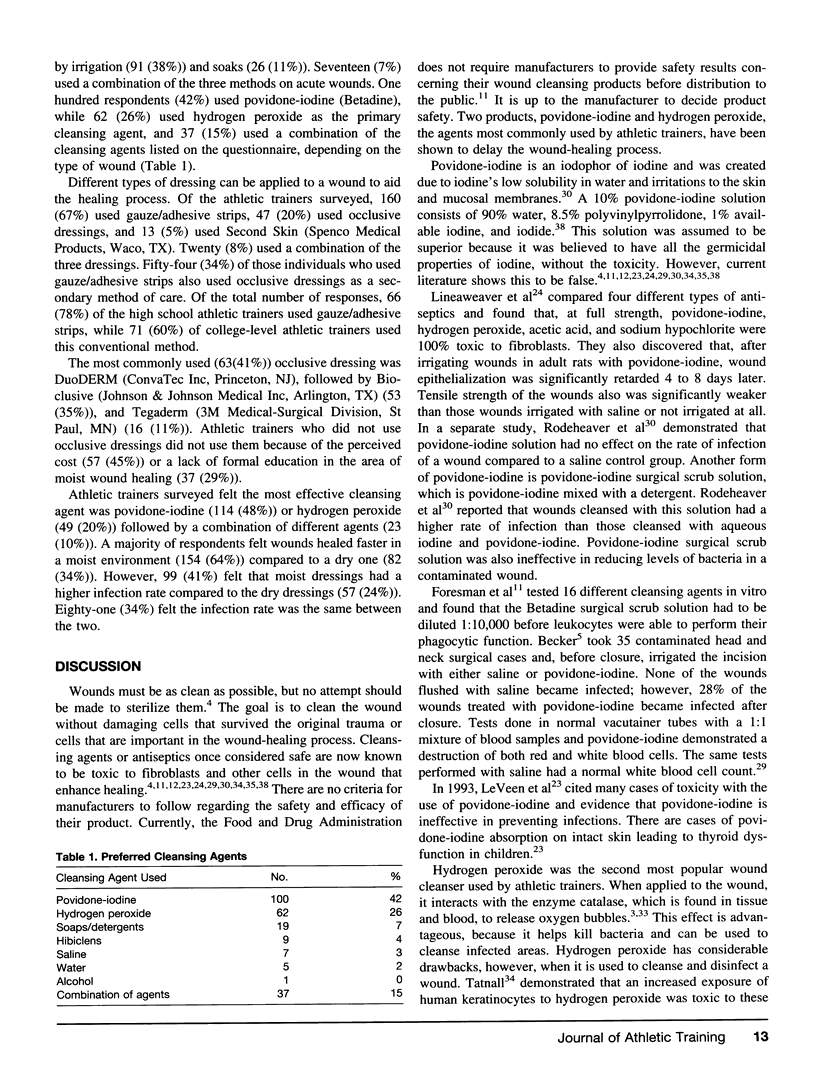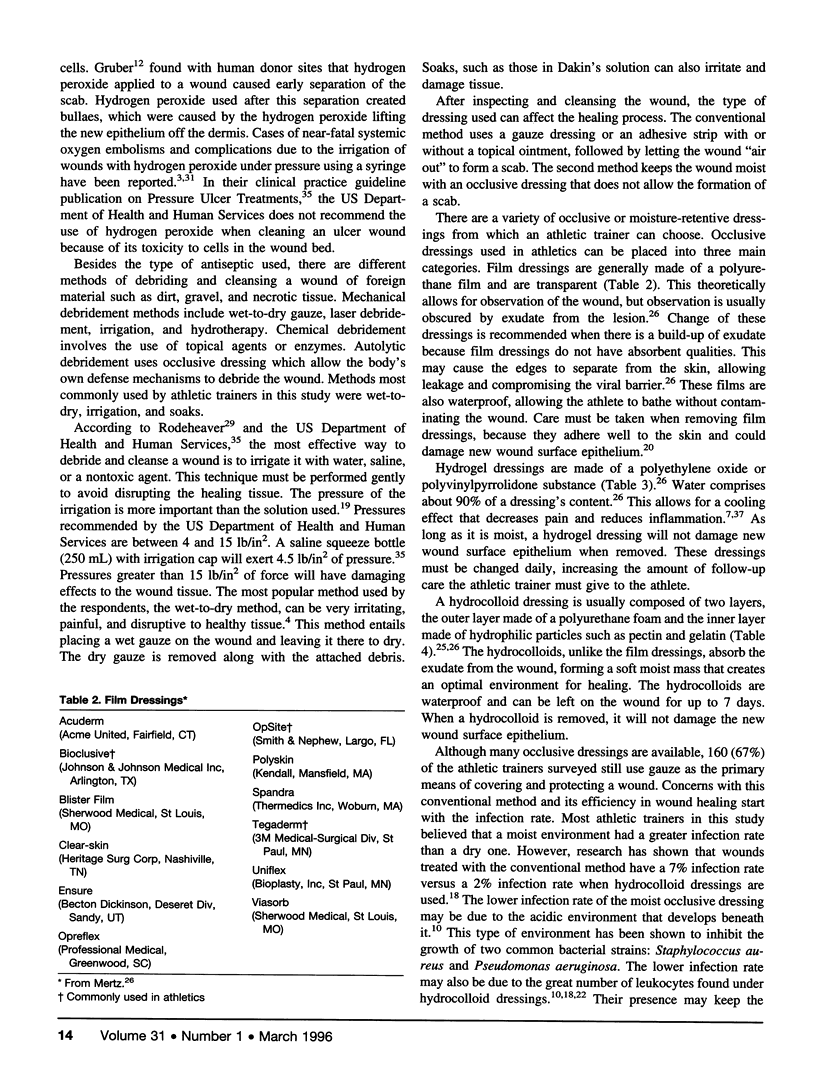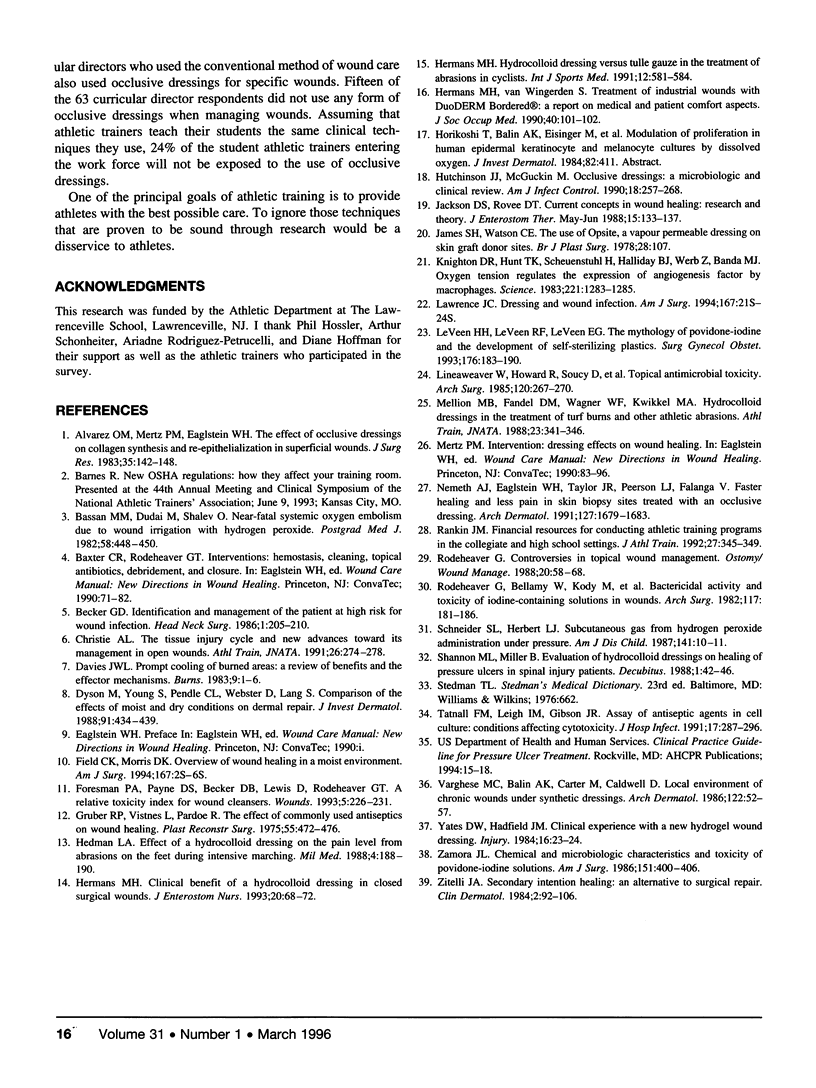Abstract
As research techniques in wound care management improve, treatment protocols for the care of wounds must also change to ensure safe and optimal healing. In this study, I surveyed current practices of athletic trainers regarding the care of athletic wounds and compared the findings to current literature. I contacted 501 athletic trainers, including all NATA curricular undergraduate directors. Overall response rate was 58%; 78% of the athletic trainers from the curricular schools responded. Wet-to-dry, irrigation, and soaks were the three most common methods used to debride and cleanse a wound. Povidone-iodine (Betadine) and hydrogen peroxide were the two most popular cleansing agents. Conventional gauze was the primary dressing used by 67% of the athletic trainers, while 20% of those surveyed used occlusive dressings. Although povidone-iodine and hydrogen peroxide are commonly used, both are toxic to cells involved in the wound-healing process and delay healing. Research indicates that the best method of cleansing and debriding a wound is to irrigate it with saline. Occlusive dressings have a lower infection rate, are viral barriers, and are associated with faster wound healing and less pain than gauze dressings. Athletic trainers need to assess their wound care protocols so that they give the best possible care to their athletes.
Full text
PDF




Selected References
These references are in PubMed. This may not be the complete list of references from this article.
- Alvarez O. M., Mertz P. M., Eaglstein W. H. The effect of occlusive dressings on collagen synthesis and re-epithelialization in superficial wounds. J Surg Res. 1983 Aug;35(2):142–148. doi: 10.1016/0022-4804(83)90136-1. [DOI] [PubMed] [Google Scholar]
- Bassan M. M., Dudai M., Shalev O. Near-fatal systemic oxygen embolism due to wound irrigation with hydrogen peroxide. Postgrad Med J. 1982 Jul;58(681):448–450. doi: 10.1136/pgmj.58.681.448. [DOI] [PMC free article] [PubMed] [Google Scholar]
- Becker G. D. Identification and management of the patient at high risk for wound infection. Head Neck Surg. 1986 Jan-Feb;8(3):205–210. doi: 10.1002/hed.2890080313. [DOI] [PubMed] [Google Scholar]
- Dyson M., Young S., Pendle C. L., Webster D. F., Lang S. M. Comparison of the effects of moist and dry conditions on dermal repair. J Invest Dermatol. 1988 Nov;91(5):434–439. doi: 10.1111/1523-1747.ep12476467. [DOI] [PubMed] [Google Scholar]
- Field F. K., Kerstein M. D. Overview of wound healing in a moist environment. Am J Surg. 1994 Jan;167(1A):2S–6S. doi: 10.1016/0002-9610(94)90002-7. [DOI] [PubMed] [Google Scholar]
- Gruber R. P., Vistnes L., Pardoe R. The effect of commonly used antiseptics on wound healing. Plast Reconstr Surg. 1975 Apr;55(4):472–476. [PubMed] [Google Scholar]
- Hedman L. A. Effect of a hydrocolloid dressing on the pain level from abrasions on the feet during intensive marching. Mil Med. 1988 Apr;153(4):188–190. [PubMed] [Google Scholar]
- Hermans M. H. Clinical benefit of a hydrocolloid dressing in closed surgical wounds. J ET Nurs. 1993 Mar-Apr;20(2):68–72. doi: 10.1097/00152192-199303000-00013. [DOI] [PubMed] [Google Scholar]
- Hermans M. H. Hydrocolloid dressing versus tulle gauze in the treatment of abrasions in cyclists. Int J Sports Med. 1991 Dec;12(6):581–584. doi: 10.1055/s-2007-1024738. [DOI] [PubMed] [Google Scholar]
- Hermans M. H., van Wingerden S. Treatment of industrial wounds with DuoDERM Bordered: a report on medical and patient comfort aspects. J Soc Occup Med. 1990 Autumn;40(3):101–102. doi: 10.1093/occmed/40.3.101. [DOI] [PubMed] [Google Scholar]
- Hutchinson J. J., McGuckin M. Occlusive dressings: a microbiologic and clinical review. Am J Infect Control. 1990 Aug;18(4):257–268. doi: 10.1016/0196-6553(90)90167-q. [DOI] [PubMed] [Google Scholar]
- Jackson D. S., Rovee D. T. Current concepts in wound healing: research and theory. J Enterostomal Ther. 1988 May-Jun;15(3):133–137. doi: 10.1097/00152192-198805000-00023. [DOI] [PubMed] [Google Scholar]
- James J. H., Watson A. C. The use of Opsite, a vapour permeable dressing, on skin graft donor sites. Br J Plast Surg. 1975 Apr;28(2):107–110. [PubMed] [Google Scholar]
- Knighton D. R., Hunt T. K., Scheuenstuhl H., Halliday B. J., Werb Z., Banda M. J. Oxygen tension regulates the expression of angiogenesis factor by macrophages. Science. 1983 Sep 23;221(4617):1283–1285. doi: 10.1126/science.6612342. [DOI] [PubMed] [Google Scholar]
- Lawrence J. C. Dressings and wound infection. Am J Surg. 1994 Jan;167(1A):21S–24S. doi: 10.1016/0002-9610(94)90006-x. [DOI] [PubMed] [Google Scholar]
- LeVeen H. H., LeVeen R. F., LeVeen E. G. The mythology of povidone-iodine and the development of self-sterilizing plastics. Surg Gynecol Obstet. 1993 Feb;176(2):183–190. [PubMed] [Google Scholar]
- Lineaweaver W., Howard R., Soucy D., McMorris S., Freeman J., Crain C., Robertson J., Rumley T. Topical antimicrobial toxicity. Arch Surg. 1985 Mar;120(3):267–270. doi: 10.1001/archsurg.1985.01390270007001. [DOI] [PubMed] [Google Scholar]
- Nemeth A. J., Eaglstein W. H., Taylor J. R., Peerson L. J., Falanga V. Faster healing and less pain in skin biopsy sites treated with an occlusive dressing. Arch Dermatol. 1991 Nov;127(11):1679–1683. [PubMed] [Google Scholar]
- Rankin J. M. Financial resources for conducting athletic training programs in the collegiate and high school settings. J Athl Train. 1992;27(4):344–349. [PMC free article] [PubMed] [Google Scholar]
- Rodeheaver G., Bellamy W., Kody M., Spatafora G., Fitton L., Leyden K., Edlich R. Bactericidal activity and toxicity of iodine-containing solutions in wounds. Arch Surg. 1982 Feb;117(2):181–186. doi: 10.1001/archsurg.1982.01380260051009. [DOI] [PubMed] [Google Scholar]
- Schneider D. L., Hebert L. J. Subcutaneous gas from hydrogen peroxide administration under pressure. Am J Dis Child. 1987 Jan;141(1):10–11. doi: 10.1001/archpedi.1987.04460010010002. [DOI] [PubMed] [Google Scholar]
- Shannon M. L., Miller B. Evaluation of hydrocolloid dressings on healing of pressure ulcers in spinal cord injury patients. Decubitus. 1988 Feb;1(1):42–46. [PubMed] [Google Scholar]
- Tatnall F. M., Leigh I. M., Gibson J. R. Assay of antiseptic agents in cell culture: conditions affecting cytotoxicity. J Hosp Infect. 1991 Apr;17(4):287–296. doi: 10.1016/0195-6701(91)90273-b. [DOI] [PubMed] [Google Scholar]
- Varghese M. C., Balin A. K., Carter D. M., Caldwell D. Local environment of chronic wounds under synthetic dressings. Arch Dermatol. 1986 Jan;122(1):52–57. [PubMed] [Google Scholar]
- Yates D. W., Hadfield J. M. Clinical experience with a new hydrogel wound dressing. Injury. 1984 Jul;16(1):23–24. doi: 10.1016/0020-1383(84)90109-8. [DOI] [PubMed] [Google Scholar]
- Zamora J. L. Chemical and microbiologic characteristics and toxicity of povidone-iodine solutions. Am J Surg. 1986 Mar;151(3):400–406. doi: 10.1016/0002-9610(86)90477-0. [DOI] [PubMed] [Google Scholar]
- Zitelli J. A. Secondary intention healing: an alternative to surgical repair. Clin Dermatol. 1984 Jul-Sep;2(3):92–106. doi: 10.1016/0738-081x(84)90031-2. [DOI] [PubMed] [Google Scholar]


